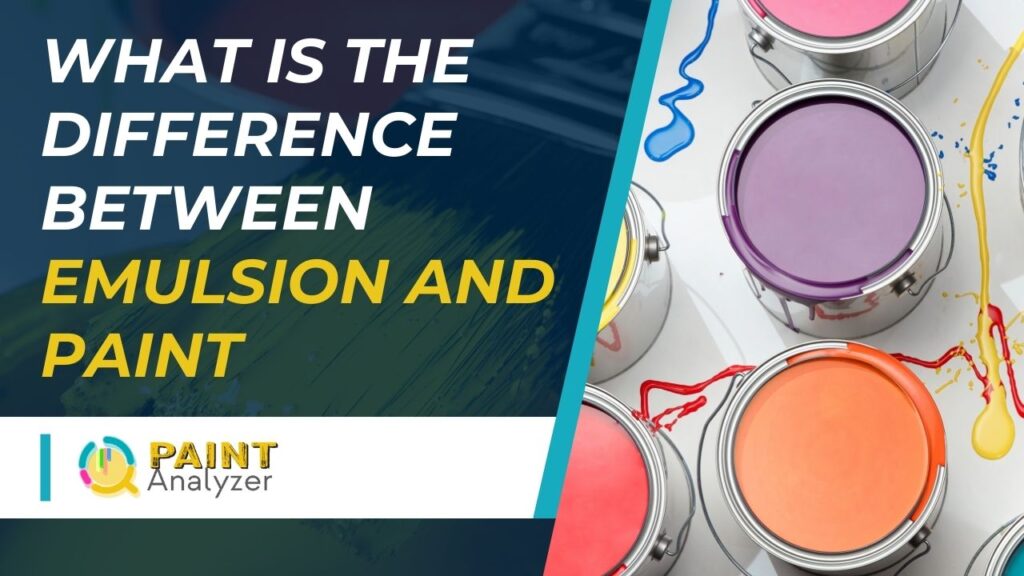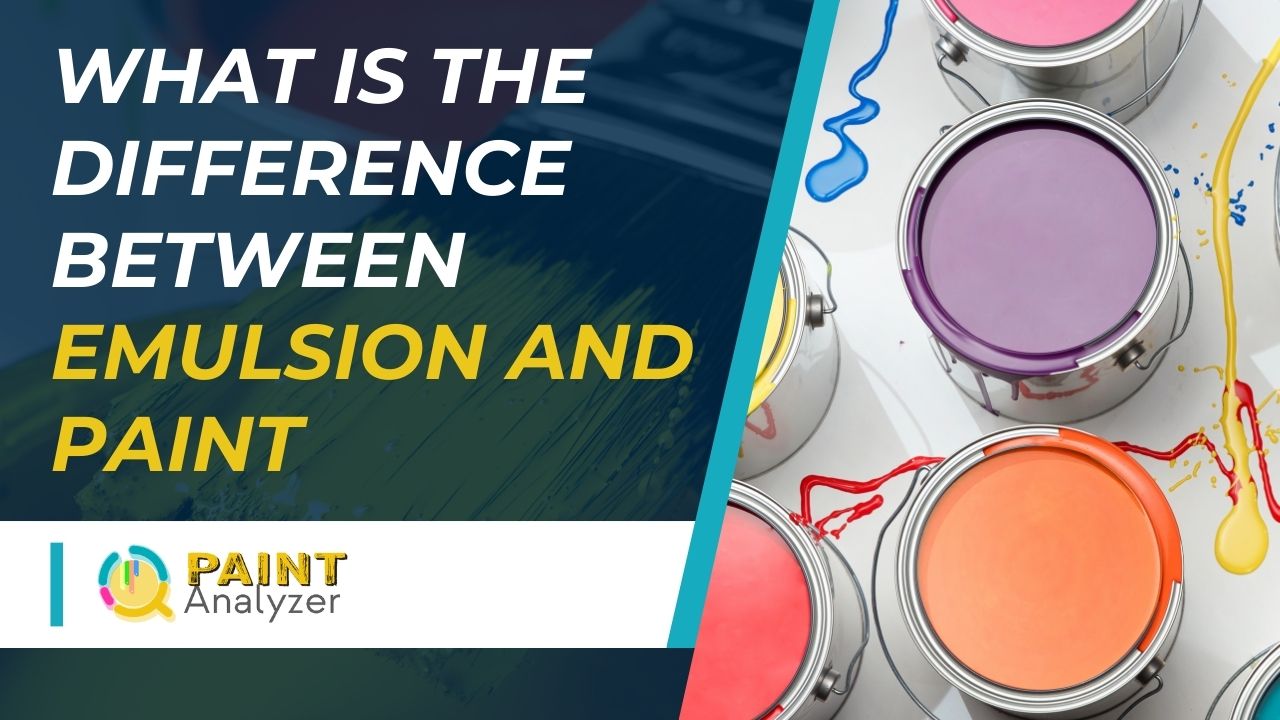Paint and emulsion are terms often used interchangeably, but there is a difference between the two. Paint is a term that covers a wide range of products that are used to protect color or provide a finish to surfaces. The emulsion is a type of paint made with a water-based formula.
Paint is available in various finishes, including matte, satin, semi-gloss, and high-gloss. Emulsion paint is typically used for interior walls and ceilings, as it has a softer, more velvety finish. It is also easier to clean than paint with a glossier finish.
Paint is typically applied with a brush, roller, or sprayer, while emulsion is often applied with a sponge or cloth. Emulsion is also thinner than paint, so follow the labels’ directions carefully to avoid applying too much.

Basic Difference Between Emulsion and Paint
Both emulsion paint and regular paint have their advantages and disadvantages, and the choice between them depends on the specific project and requirements.
Here’s a table comparing emulsion paint and regular paint:
| Aspect | Emulsion Paint | Regular Paint |
|---|---|---|
| Base | Water-based | Oil-based or Water-based (latex) |
| Finish | Matte or Low Sheen | Glossy, Satin, Semi-Gloss, or Matte |
| Odor | Low odor | Strong odor (oil-based), Low odor (latex) |
| Drying Time | Quick drying | Slower drying time (oil-based), Faster (latex) |
| Clean-up | Easy cleanup with water | Requires solvents (oil-based), Water (latex) |
| Durability | Generally less durable than oil-based paints | Can be more durable, especially oil-based |
| Coverage | May require more coats for full coverage | Often provides better coverage |
| Flexibility | Offers better flexibility and is less prone to cracking | Can crack over time, especially oil-based |
| Surface Preparation | Requires less surface preparation | May need more thorough preparation |
| Application | Often used for interior walls and ceilings | Used for various surfaces and projects |
| Colors | A wide range of colors and finishes are available | Available in various colors and finishes |
| Usage | Preferred for residential interiors | Used for both interior and exterior projects |
| Health Concerns | Generally considered safer and less toxic | Oil-based paints can release harmful fumes |
What Is Emulsion Paint Used For?
Emulsion paint is a liquid paint made up of tiny droplets of color suspended in water. It’s commonly used for walls and ceilings because it dries quickly, has a low odor, and cleans up easily with soap and water. There are two types of emulsion paints: acrylic and vinyl.
Acrylic emulsions are made from synthetic resins, while vinyl emulsions are made from natural resins. Both types of paint provide a durable, long-lasting finish that resists fading and chalking.
Emulsion paints can be used on various surfaces, including wood, plaster, drywall, and concrete. They’re available in various colors, sheens, and finishes to suit any project.
Can Emulsion Be Used Instead Of Paint?
Paints are versatile and can be used for various purposes, from interior to exterior, protecting surfaces, and providing a decorative finish. However, with so many different types of paints on the market, it cannot be easy to know which one to use for your project. So, can emulsion be used instead of paint?
Generally speaking, emulsion is a type of paint that is used for walls and ceilings. It is made from a water-based formula and typically has a matt finish. However, there are also emulsions available with a satin or semi-gloss finish. One of the main benefits of using emulsion is that it is quick, easy to apply, and dries relatively quickly.
So, if you want to paint a wall or ceiling in your home, then emulsion is a good option. And for that case, emulsion can be used instead of paint. Also, it will provide more durability than paint and will be less likely to show imperfections on your painting surface.
But other than walls and ceilings, emulsion is not really suitable for use on other surfaces such as wood or metal. For these surfaces, you would be better off using a different type of paint, such as an oil-based paint or a primer.
So using emulsion instead of paint depends on what surface you are painting and what finish you want.
The Difference between Emulsion And Satin Paint
It is a myth that paint and emulsion are the same things. Emulsion is a type of paint, but there are differences between the two. Here are the core differences between paint and emulsion:
Paint Type
Paint is a general term for a product used to protect or decorate a surface. On the other hand, emulsion is a type of paint made with water-based latex. It is usually used for interior walls and ceilings.
Viscosity
Paint is typically thicker than emulsion, so applying evenly can be more challenging. On the other hand, emulsion has a thinner consistency, making it easier to spread evenly on a surface.
Drying Time
Paint typically takes longer to dry than emulsion. This is because the paint is thicker and needs more time to set. On the other hand, emulsion dries relatively quickly since it is thinner.
Finish
Paint can give a surface a matte or glossy finish, depending on your paint type. Emulsion, on the other hand, usually gives a surface a more matte finish.
Coverage
Paint usually provides better coverage than emulsion since it is thicker. Conversely, emulsions may require more coats to achieve the same level of coverage as paint.
Cost
Paint is typically more expensive than emulsion since it is a more versatile product. Emulsion is typically less expensive since it is designed for interior walls and ceilings.
Cleanup
Paint usually requires more cleanup since it is thicker. Emulsion, on the other hand, is easier to clean up since it is thinner.
Durability
Paint is typically more durable than emulsion since it is thicker. Emulsion, on the other hand, is less durable since it is thinner.
Safety
Paint usually contains more volatile organic compounds (VOCs) than emulsions. VOCs can harm your health, so choosing paint with low VOCs is important if you are concerned about your health. On the other hand, emulsion typically has lower VOCs since it is water-based.
Use
Paint is typically used for both interior and exterior surfaces. Emulsion is usually used for interior surfaces only.
How does the use of emulsion or paint affect achieving a wet edge when painting?
When using the wet edge painting technique, emulsion or paint can affect the outcome. Emulsion paint tends to dry faster, making it trickier to maintain a wet edge. On the other hand, oil-based paint has a slower drying time, making it easier to achieve a seamless finish with the wet edge painting technique.
Emulsion Paint Vs. Oil Paint
Conclusion
While both emulsion and paint have their own unique properties and benefits, they are fundamentally different in terms of their composition and application. Emulsion is essentially a water-based paint that consists of emulsifiers, resins, and pigments, while paint typically contains solvents, binders, and pigments.
Emulsion is ideal for use on interior walls and ceilings, while the paint is better suited for outdoor surfaces and furniture. Understanding the differences between these two products can help you make an informed decision when it comes to choosing the right option for your project.

